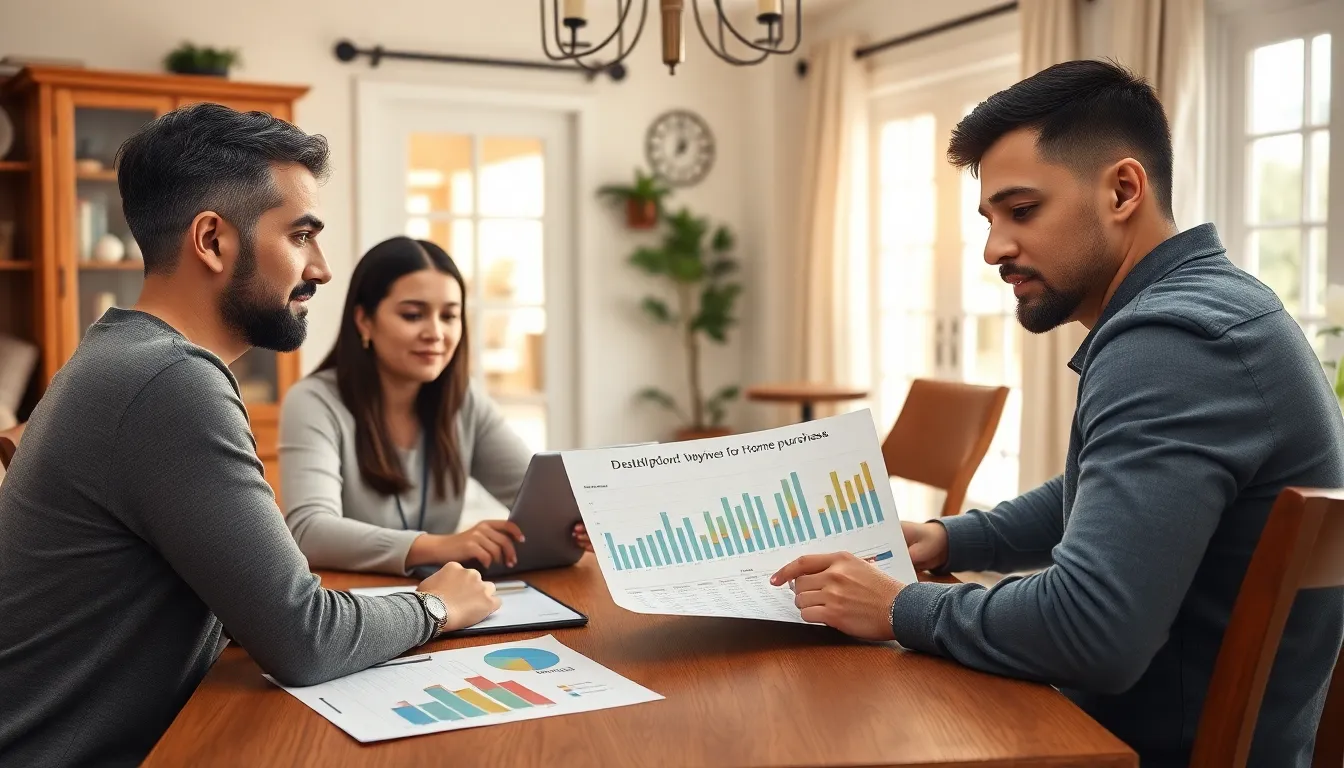Buying a home is like dating; you don’t want to fall head over heels for something that’ll leave you broke and heartbroken. The question isn’t just about finding the perfect kitchen or a backyard for your future dog—it’s about figuring out how much home you can actually afford without sacrificing your daily coffee fix or that Netflix subscription.
Table of Contents
ToggleUnderstanding Affordability
Affordability plays a crucial role in the home-buying process. It ensures that homeowners can balance their financial commitments without sacrificing their quality of life.
Key Factors to Consider
Location impacts affordability directly. Homes in desirable neighborhoods tend to cost more. Income significantly affects how much one can afford. Higher income levels generally allow for larger mortgages. Debt-to-income ratios also hold considerable weight; keeping debts low aids in securing more favorable loan terms. Credit scores matter as well; better scores yield lower interest rates. Finally, market conditions can fluctuate; during a seller’s market, prices often rise, influencing overall affordability.
The 28/36 Rule Explained
The 28/36 rule serves as a guideline for potential homeowners. A household’s monthly housing expenses should not exceed 28% of gross monthly income. This includes mortgage payments, property taxes, and homeowners insurance. Additionally, total monthly debts should stay within 36% of gross monthly income. This second figure encompasses housing costs plus other debts like car loans and credit cards. Following this rule provides a more realistic overview of budget constraints, ensuring a balanced financial approach.
Calculating Your Budget

Budgeting for a home purchase requires thorough evaluation of financial aspects. Key factors revolve around income and monthly expenses.
Evaluating Your Income
Calculating total gross income aids in determining affordability. This figure includes wages, bonuses, and any side income sources. Understanding net income reveals what money is available for housing costs. Consider recent pay stubs or tax returns for accuracy. Lenders often assess income stability, typically reviewing the past two years. Consistent income boosts confidence in borrowing potential.
Assessing Your Monthly Expenses
Listing all monthly expenses provides a clear financial picture. Include fixed costs like rent, utilities, and insurance premiums. Variable expenses such as groceries and entertainment also affect financial flexibility. Analyzing discretionary spending reveals areas for savings. Knowing total monthly expenses ensures alignment with the 28/36 rule. This approach aids in identifying a realistic budget for homeownership.
Mortgage Options
Mortgage options play a crucial role in determining how much home someone can afford. Selecting the right mortgage impacts monthly payments, long-term debt, and overall financial stability.
Fixed-Rate vs. Adjustable-Rate Mortgages
Fixed-rate mortgages provide stability with consistent monthly payments for the entire loan term. This predictability allows homeowners to budget effectively without worrying about fluctuating rates. In contrast, adjustable-rate mortgages (ARMs) offer initially lower rates but can change over time, which may lead to higher payments later. ARMs might appeal to those planning to sell or refinance before the adjustment period begins. Understanding these options helps potential homeowners assess which type aligns best with their financial situation and long-term goals.
Down Payment Considerations
Down payments significantly influence mortgage affordability. Typically, a down payment of 20% avoids private mortgage insurance (PMI), reducing monthly payments. Lower down payments may make homeownership more accessible, though they often come with PMI, which increases monthly costs. Potential homeowners need to evaluate how much they can comfortably allocate for a down payment without jeopardizing their savings. Considering various loan programs can also help buyers identify options that fit their down payment capabilities.
Additional Costs of Homeownership
Homeownership involves additional costs beyond the mortgage. It’s essential to plan for these expenses to maintain a balanced budget.
Property Taxes and Insurance
Property taxes typically vary by location and can significantly impact monthly expenses. Homeowners often pay between 0.7% to 2.1% of the home’s assessed value annually. Insurance premiums also add to costs, often ranging from $800 to $1,500 per year, depending on factors like coverage levels and property location. Both expenses require adequate budgeting to avoid financial strain. In many areas, lenders include property taxes and insurance in monthly mortgage payments, ensuring these costs are accounted for systematically.
Maintenance and Repairs
Homeownership brings ongoing maintenance and repair responsibilities. It’s advisable to set aside 1% to 3% of the home’s purchase price each year for maintenance. Regular upkeep, such as lawn care and appliance servicing, plus unexpected repairs like roof fixes or plumbing issues, can quickly accumulate. Budgeting for these regular and emergency costs helps maintain a home’s value while avoiding financial headaches. Considering this, creating a dedicated fund for repairs can support homeowners in managing these inevitable expenses more effectively.
Making the Decision
Calculating how much home to afford involves using tools and resources to ensure a well-informed decision. Online calculators can help estimate monthly payments based on variables like loan amount, interest rates, and down payments. Many financial websites offer affordability calculators, simplifying the process for users. Government resources also provide guidelines on housing assistance programs and support for first-time buyers.
Seeking professional advice plays a vital role in determining affordability and navigating the home-buying process. Engaging with a financial advisor ensures tailored advice based on individual circumstances. Furthermore, real estate agents provide valuable insights into local market conditions, helping potential homeowners make informed decisions. Mortgage brokers aid in understanding financing options, ensuring alignment with financial goals. Prioritizing expert opinions enhances confidence in making a sound investment.
Finding the right balance between affordability and quality of life is essential for prospective homeowners. By understanding personal finances and adhering to guidelines like the 28/36 rule, individuals can make informed decisions that align with their budgets.
Exploring various mortgage options and considering all associated costs ensures a holistic approach to homeownership. Engaging with professionals can provide valuable insights and help navigate the complexities of the market.
Ultimately, making a well-informed choice leads to a satisfying home-buying experience without compromising financial stability.













